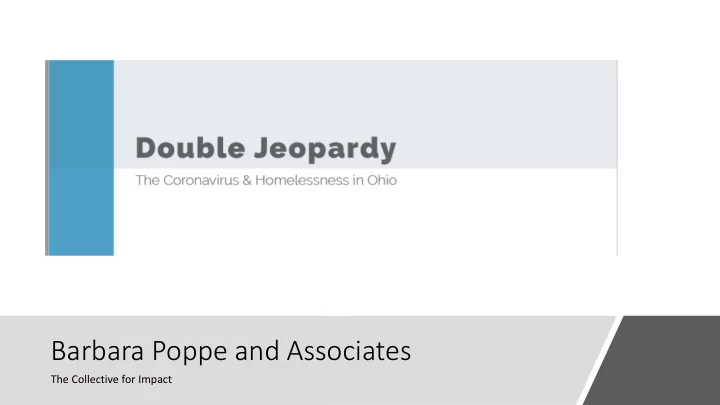

Barbara Poppe and Associates The Collective for Impact
Purpose • Understand the status of preparedness to address COVID-19 pandemic response in the context of homelessness • Highlight newly published research by a team of national experts • Advance ways to better respond to the pandemic • Call to action for philanthropy, business and government at all levels
Continuum of Care
Scope of Homelessness in Ohio • Point In Time estimates (2019) • 10,000 people are homeless and residing in temporary quarters, predominately congregate facilities • 2,100 people are homeless and unsheltered • Annual estimates (2017) • 70,123 Ohioans accessed homelessness services during year • 20% higher in 2017 v. 2012 • Largest increases in population served have been among young children and older adults • 300+ facilities statewide
Age-specific risk for homelessness-adjusted scenarios in comparison to general population Panel A: Hospitalization Panel B: Critical Care 40% 30% 35% 25% 30% 20% 25% 20% 15% 15% 10% 10% 5% 5% 0% 25-29 30-34 35-39 40-44 45-49 50-54 55-59 60-64 65-69 70-74 75-79 80-84 85-89 0% 25-29 30-34 35-39 40-44 45-49 50-54 55-59 60-64 65-69 70-74 75-79 80-84 85-89 General Homeless General Homeless Dennis Culhane, Daniel Treglia, Ken Steif, Randall Kuhn, Thomas Byrne. (2020). Estimated Emergency and Observational/Quarantine Bed Need for the US Homeless Population Related to COVID-19 Exposure by County; Projected Hospitalizations, Intensive Care Units and Mortality . Retrieved from Washington, DC: https://endhomelessness.org/wp- content/uploads/2020/03/COVID-paper_clean-636pm.pdf
CDC Recommendations • Appropriate plans in place with protocols about connecting healthcare facilities to assess and treat symptomatic and suspected cases • All homeless assistance providers trained, equipped and prepared to follow CDC guidelines • Existing shelter programs have deconcentrated to enable social distancing and have begun screening • Safe shelter options available people who are unsheltered and outreach trained and equipped • Quarantine and isolation capacity for those who are symptomatic or have been confirmed
Gaps in Planning and Preparation • 46% of CoCs have established a joint response plan to COVID-19 with their local health department • 46% reported that most or all of their homeless service providers had received training and education on COVID-19 • 49% are unaware of how to proceed when a possible COVID-19 case is identified • 75% report that emergency shelter capacity within their region has not been reconfigured to accommodate recommendations • 71% do not have sufficient sanitation and hygiene supplies on hand to prevent transmission of COVID-19
Isolation/quarantine space for people/families with mild COVID-19 symptoms
Real questions, no easy answers "Major problem is the configuration of the shelters themselves - there is no place to isolate or quarantine. The hope is to identify a sick person before they enter a shelter, but even though some trying to take temperatures, what to do if discovered? Health department says if 100.4, don't allow person into the shelter. Then what is the person to do?” "At this time, shelters anticipate they will have to quarantine in place, as it's likely someone will be identified with COVID-19 after entry, not before. None of our local shelters has the capacity to isolate or quarantine a space within the shelter. The entire shelter would need to be quarantined. If the health department identifies a COVID-19 case in a homeless person, the Department indicated they can pay for a motel stay but there is no immediate plan in place."
Dealing with harsh realities
Additional shelter capacity to deconcentrate existing facilities and expand • shelter options to accommodate unsheltered individuals Identify and set up spaces and hotels for isolation and quarantine • Provide public health guidance and protocols for establishing, equipping and • staffing shelter, quarantine, and isolation spaces for people enduring homelessness Immediate Provide guidance on how to connect the homeless assistance system with • the medical response to COVID-19 Needs Expand efforts to provide emergency assistance to divert from shelter and • rapidly exit people from homelessness – funding will be required Ensure every facility and program has adequate staff, supplies, and food • Improved coordination and communication about homeless-specific • responses to COVID-19 across state agencies and with local public health districts, emergency management agencies, and healthcare systems
People who are enduring homelessness are diverse – yet all share a lack of a safe, home and are trying to stable place to call ho get by depending on the charity of emergency shelters or sleeping in abandoned buildings § Pregnant women with young children fleeing domestic violence § Middle aged workers who lost their jobs due to injury § Older women with histories of depression and mental illness § Young people struggling to free themselves from opioid addiction § Vietnam-era Veterans who lost their homes in a recent divorce
"This is a war on a silent enemy, I don't want you to Dr. Amy be afraid. I am not afraid. I am determined, but I Acton, need you to do everything. I want you to think about the fact this is our one shot in this country. Director of All of us are going to have to sacrifice, and I know someday we will be looking back and wondering the Ohio what it was we did in this moment. There will be so many heroes.” Department "Everyone is being heroic right now, and I can tell of Health you that every action you take is mattering, but this is that moment. It is our one shot.”
• We can defeat this silent enemy by pulling together across sectors – business, philanthropy, government, faith-based, civic, and nonprofit organizations – and across disciplines – public health, disaster response, healthcare, social services, housing, and public Call to Action service. • An all hands-on deck approach is essential as we set aside our other priorities and focus on ways to reduce the spread of the virus, save lives, and make Ohio healthier for everyone.
Recommend
More recommend